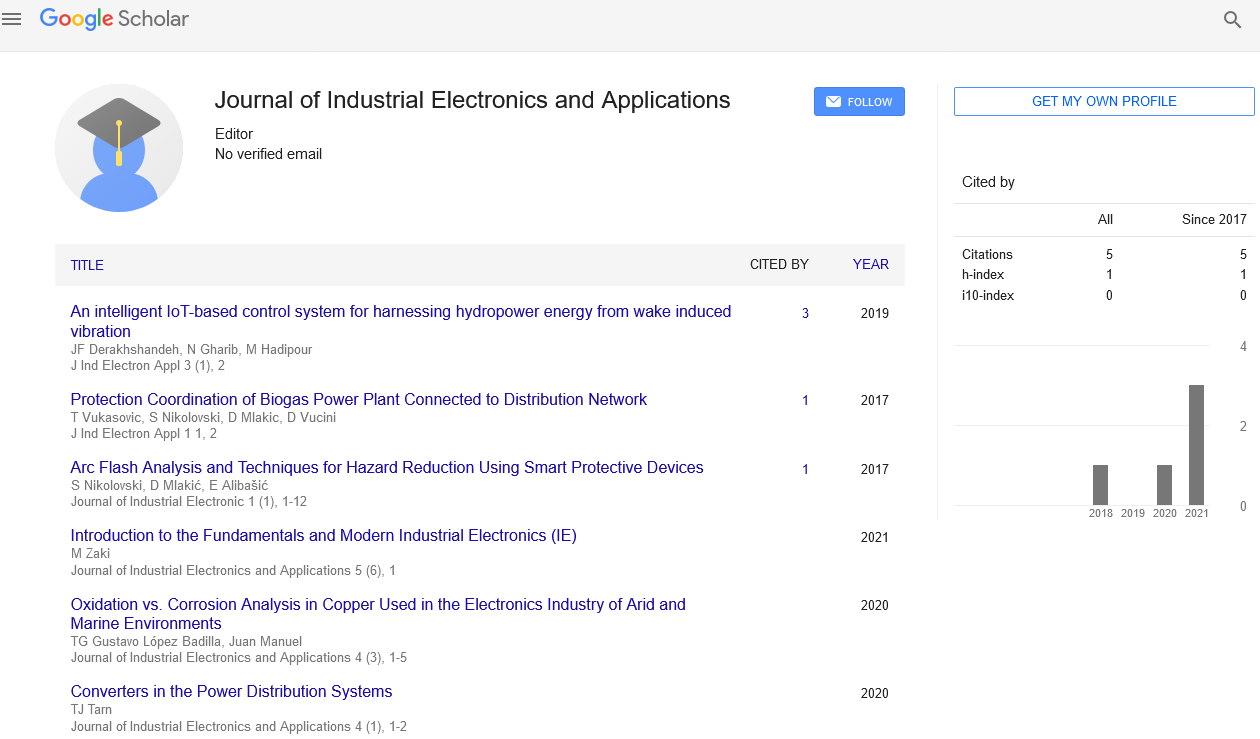Opinion Article, Vol: 7 Issue: 3
Power Electronics: Its Transformative Effects on Modern Technologies
Chen Wook*
1Department of Electrical and Computer Engineering, University of Windsor, Windsor, Canada
*Corresponding Author: Chen Wook,
Department of Electrical and Computer
Engineering, University of Windsor, Windsor, Canada
E-mail: chenwook.123@gmail.com
Received date: 05 September, 2023, Manuscript No. JIEA-23-117719;
Editor assigned date: 07 September, 2023, PreQC No. JIEA-23-117719 (PQ);
Reviewed date: 21 September, 2023, QC No. JIEA-23-117719;
Revised date: 29 September, 2023, Manuscript No. JIEA-23-117719 (R);
Published date: 06 October, 2023, DOI: 10.36648/JIEA.1000037.
Citation: Wook C (2023) Power Electronics: Its Transformative Effects on Modern Technologies. J Ind Electron Appl 7:3.
Abstract
Description
Power electronics is a rapidly evolving field of electrical engineering that plays a crucial role in transforming and managing electrical power efficiently. It has revolutionized our world by impacting various industries, from consumer electronics and renewable energy to transportation and industrial automation the fundamentals of power electronics, its applications, and its transformative effects on modern technology. Power electronics is a branch of electrical engineering that deals with the conversion and control of electrical power. It primarily focuses on converting electrical energy from one form to another, ensuring that it's delivered efficiently and reliably to meet the needs of various applications. The key components in power electronics are semiconductors like diodes, transistors, and thyristors.
Key components of power electronics
Diodes allow current to flow in one direction and block it in the other. They are commonly used in rectifiers to convert Alternating Current (AC) into Direct Current (DC). Transistors are used for switching applications. They can rapidly turn on and off, controlling the flow of current. Common types include MOSFETs and IGBTs. Thyristors, like Silicon-Controlled Rectifiers (SCRs), are used for high-power switching applications. They are unidirectional switches that are ideal for phase control.
Applications of power electronics
Power electronics is integral to our everyday lives. It enables the efficient conversion and regulation of power in devices like smartphones, laptops, and televisions. Switch-mode power supplies, which use power electronics, have made these devices smaller, lighter, and more energy-efficient. Power electronics plays a pivotal role in renewable energy systems. In solar power installations, for instance, it converts the DC power generated by solar panels into usable AC power for the grid. Wind turbines also use power electronics for efficient power conversion and grid synchronization. The Electric Vehicle (EV) industry heavily relies on power electronics for motor control and energy conversion. Power inverters in EVs are essential for converting the DC power stored in batteries into AC power to drive the vehicle. This is crucial for reducing emissions and transitioning to sustainable transportation. In industrial settings, power electronics is used for motor control and process optimization. Variable Frequency Drives (VFDs) and soft starters, which are based on power electronics, control the speed and torque of motors, leading to energy savings and improved process control. Electronics is critical in aerospace and defense applications for high-frequency switching and power distribution. It is used in radar systems, communication equipment, and advanced avionics. Power electronics is instrumental in the healthcare sector, ensuring precision and reliability in medical equipment like MRI machines, CT scanners, and patient monitoring devices. In power distribution and grid management, power electronics is essential for maintaining the stability of the electrical grid. Devices like STATCOMs and FACTS controllers enhance grid reliability and power quality.
Transformative effects
Power electronics has transformed our world in numerous ways. It has improved the energy efficiency of devices and systems, reducing energy consumption and greenhouse gas emissions. Power electronics has accelerated the electrification of various industries, leading to cleaner and more sustainable energy use. The miniaturization of electronic devices and systems is largely attributed to power electronics, which has made gadgets more portable and efficient.
Conclusion
Power electronics is an integral part of modern technology, impacting industries, from consumer electronics to renewable energy and transportation. As it continues to advance, we can expect further innovations that will make our world more energy-efficient and sustainable. The future of power electronics promises cleaner and more efficient energy management, which is essential in addressing the challenges of a rapidly changing world. The growth of renewable energy sources is made possible by power electronics, paving the way for a more sustainable future. Electric vehicles have the potential to revolutionize transportation, and power electronics is at the heart of this transformation.
 Spanish
Spanish  Chinese
Chinese  Russian
Russian  German
German  French
French  Japanese
Japanese  Portuguese
Portuguese  Hindi
Hindi 